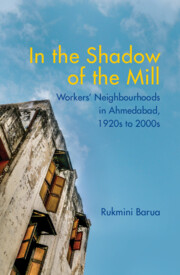6 - Violence, Law and ‘Ghettoisation’
Published online by Cambridge University Press: 15 June 2022
Summary
In October 2012, Ahmedabad hosted India's first-ever ‘Muslim’ property show. It was a three-day affair showcasing properties in ‘Muslim’ areas of the city, such as Juhapura, Sarkhej and Vatva. The organiser of this exhibition, Ali Hussein of Ummat, a web portal for Muslim businesses in the city, understands this development as a way of tapping into a potential ‘buyer group’: ‘There was already a mature need for this. Time, even more than me, has contributed to the success of this show.’ What exactly has the role of time been in creating this demand for ‘Muslim’ properties? What are the historical processes that have led to the production of two distinct and separate property markets in the city?
From the histories of chawl housing explored in the previous chapter, we now turn to questions of segregation and ghettoisation, which have critically shaped the dynamics of housing and property in Ahmedabad. A particular focus is placed on the enactment and implementation of the Prohibition of Transfer of Immovable Properties in Disturbed Areas Act of 1986, which, I contend, contributed heavily to the production of communalised spaces in the city. The juridical roots of present-day segregation of Ahmedabad could be traced back to the riots of 1985–86 and the legal strategies that were designed to contain it. What began as caste riots over the issue of reservations soon morphed into communal violence, rapidly gathering momentum in the working-class neighbourhoods of eastern Ahmedabad. This episode of violence (and those that followed) was marked by not just a loss of life and property, but also a reordering of social space, as neighbourhoods became increasingly communally homogenous. This demographic change was fuelled by rampant distress sales, which reached such alarming proportions during the riots of 1985–86 that the Gujarat government placed restrictions on property transfers in notified ‘disturbed areas’. Contrary to its professed intentions, this piece of government legislation eventually formed the basis for the communalisation of the city's real estate and became the legal instrument through which ghettoisation was normalised.
Even during casual conversations in Ahmedabad, while taking an autorickshaw, for instance, or discussing where to eat, the notions of ‘Hindu’ and ‘Muslim’ areas surface regularly. The very categories of ‘Hindu’ and ‘Muslim’ (identities and space), as Desai and Shani argue, are increasingly fixed, naturalised and posed in antagonism to each other.
- Type
- Chapter
- Information
- In the Shadow of the MillWorkers' Neighbourhoods in Ahmedabad, 1920s to 2000s, pp. 213 - 237Publisher: Cambridge University PressPrint publication year: 2022

